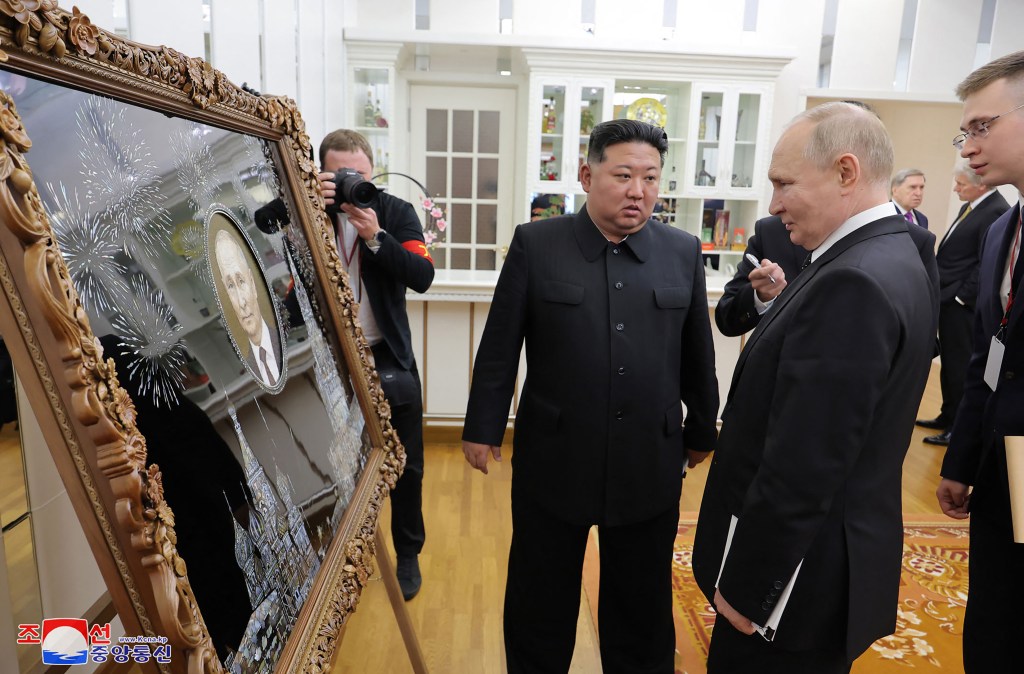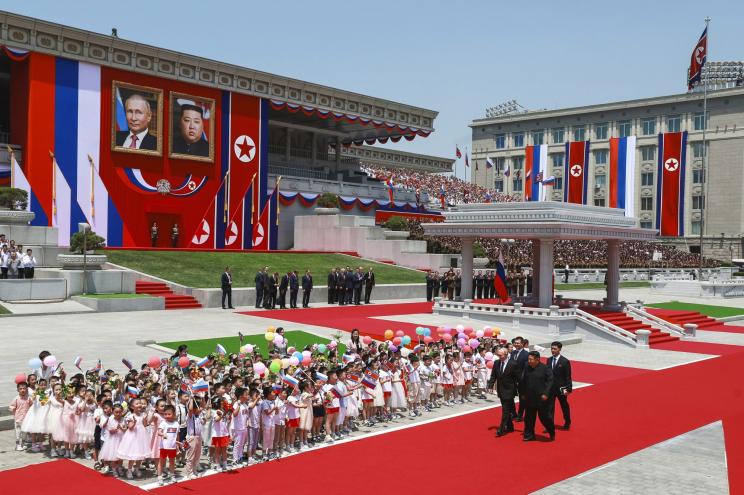For anyone slow on the uptake, Presidents Vladimir Putin and Kim Jong-un provided some helpful show-and-tell in Pyongyang on Wednesday.
A year ago, I warned that a new “Axis of Ill Will” was forming.
Now you get my drift.
Kim gave Putin a vintage 1930s reception, complete with vast flags, red carpets and temporarily well-fed children.
The two signed a pact committing themselves to mutual assistance in the event of “aggression” against either country.
Putin hinted at the “development of military-technical cooperation” — the least he can do in return for the dozens of ballistic missiles and 11,000 shipping containers of munitions that (according to US intelligence) Kim has sent him to carry on Russia’s aggression against Ukraine.
With a cynicism worthy of Joseph Stalin, Putin thanked Kim for his “consistent and unwavering support” against “the hegemonic and imperialist policy” of the United States.
The new recruit
Kim is a relatively new recruit to an Axis that originated in Beijing three weeks before the Russian invasion of Ukraine, when Putin signed a “no limits” security pact with Xi Jinping, the Chinese leader.
In March 2023, the two dictators met again.
“Right now, there are changes, the likes of which we haven’t seen for 100 years,” Xi told Putin at the Kremlin.
“And we are the ones driving these changes together.”
The fourth member of the Axis of Ill Will is the Islamic Republic of Iran, led by Ali Khameini (inset, far right).
After Hamas’s Oct. 7 pogrom in Israel, China promptly took the Palestinian side at the United Nations as well as in social media, where TikTok has been a key channel for anti-Israel propaganda.
The Chinese are, of course, the number-one buyers of Iran’s oil exports.

The Russians, meanwhile, have been buying drones from the Iranians and massive quantities of dual-use hardware from China.
The British government believes China is now sending Russia weapons, too.
The “Axis of Evil” that George W. Bush talked about after 9/11 was a speechwriter’s flight of fancy.
The Axis of Ill Will is real — and becomes better organized with every passing month.
The original Axis was dreamt up by Benito Mussolini in 1936, to mark the signing of a protocol pledging lasting friendship between Fascist Italy and Nazi Germany.
Of course, now as then, an Axis is an alliance between villains, based on mistrust as much as common interest.
When Germany went to war with Poland, France and Britain in September 1939, Mussolini waited to see who had the upper hand before joining forces with Hitler.
Likewise, China and Russia are setting aside centuries of mutual antagonism to maintain today’s Axis.
There is no love lost between Moscow and Beijing — witness the hard bargain the Chinese are driving over a new gas pipeline from Russia to China.
But what all four Axis members can agree on — despite their many differences — is that the era of American primacy needs to be terminated.
What’s more, they are doing a good job of persuading many developing countries in the so-called “Global South” to take their side, blaming the war in Ukraine on NATO expansion and now claiming — as Xi told European Commission President Ursula von der Leyen last year — that Washington is trying to goad Beijing into attacking Taiwan.
Emboldened by Biden
The Axis has of course been emboldened by Joe Biden’s preference for “de-escalation” over deterrence.
Having failed to deter the Taliban in Afghanistan (2021), the Russians in Eastern Europe (2022) and the Iranians and their proxies in the Middle East (2023), the Biden administration now looks alarmingly capable of repeating the process in the Far East this year.
Republican national security hawks such as Matt Pottinger and Mike Gallagher complain that Biden’s policy is no better than the détente of the 1970s, which (they argue) failed to deter the Soviet Union from aggression all over what was then called the Third World.
Donald Trump’s national security adviser, Robert O’Brien, took a similarly critical line last week.
And in a damning report just published, Republican Sen. Roger Wicker has warned that “America’s military has a lack of modern equipment, a paucity of training and maintenance funding, and a massive infrastructure backlog. . . . It is stretched too thin and outfitted too poorly to meet all the missions assigned to it at a reasonable level of risk. Our adversaries recognize this, and it makes them more adventurous and aggressive.”
The new Republican line — which is markedly different from the Russophile isolationism of Tucker Carlson — is that it is time for America to get tough with the Axis.
“The United States shouldn’t manage the competition with China; it should win it,” Pottinger and Gallagher opined in a recent article for Foreign Affairs.
“A cold war is already being waged against the United States by China’s leaders. . . . Victory requires openly admitting that a totalitarian regime that commits genocide, fuels conflict, and threatens war will never be a reliable partner.”
Risky aggression
In response, foreign policy liberals argue that it would be risky for the United States to be more combative, especially towards China.
The Yale historian Arne Westad warns that “China [is] making military plans to . . . invade Taiwan, producing a war between China and the United States just as the Schlieffen Plan helped produce a war between Germany and Britain” in 1914.
Unless the US and China dial back their rhetoric, “Taiwan . . . could be the Balkans of the 2020s. Both China and the United States seem to be sleepwalking toward . . . confrontation.”
What Biden’s critics have in common is a conviction that the US needs to up its military game.
Pottinger and Gallagher want the defense budget increased from 3% of GDP to “4 or even 5%.”

O’Brien, too, wants Ronald Reagan to be Trump’s model if he is re-elected on Nov. 5.
“Congress and the executive branch,” O’Brien writes, “should recommit to the goal of having a 355-ship navy by 2032, which Trump set in 2017.”
The government should also build 100 (or more) B-21 stealth bombers, resume production of uranium-235 and plutonium-239 to upgrade the US nuclear arsenal, and invest in hypersonic missiles.
Wicker’s report is an even longer shopping list of new weapons the Pentagon needs to buy.
There’s only one problem.
While it is quite easy for Republican hawks to call for increased spending on weapons and defense research, it is much harder to say where the money will come from.
According to the latest report of the Congressional Budget Office, the US budget deficit will be around $1.9 trillion this year — a whopping 6.9% of GDP, compared with the 5.6% it forecast in February.
That’s an astounding number at a time of near-full employment, reflecting the fact that the Biden administration just keeps overspending on everything from foreign aid to student-loan forgiveness.
Defense $$ ‘unlikely’
As O’Brien himself admits, “large increases to defense expenditures are unlikely” even if Trump wins in November.
Already this year, interest payments on the federal debt will exceed the defense budget.
This is where I get very uneasy.
According to the only law of history I have ever discovered, any great power that spends more on debt service than on its armed services doesn’t stay great for long.
Now, you can believe — as Jake Sullivan evidently does — that economic measures will suffice to rein in the Axis of Ill Will, and that Americans themselves will be able to avoid fighting wars.
Protectionist tariffs and export controls have their uses, no doubt.
But — as with sanctions, which have conspicuously failed to cripple Russia’s war economy — those should not be exaggerated.
China suffers setbacks when the US restricts its access to the most sophisticated semiconductors, but it is not clear that the setbacks are more than temporary.
As the former Google chair Eric Schmidt has said: “For now, the United States remains in the lead [in artificial intelligence]. But China is catching up in many areas and has already surged ahead in others.”
According to the Australian Strategic Policy Institute’s Critical Technology Tracker, “China’s global lead extends to 37 out of 44 technologies that ASPI is now tracking, covering a range of crucial technology fields spanning defense, space, robotics, energy, the environment, biotechnology, artificial intelligence, advanced materials, and key quantum technology areas.”
In the past five years, to give just one example, China generated just under half of the world’s high-impact research papers on advanced aircraft engines, including hypersonics.
This should make all sentient Americans pay attention.
For, if China is not merely catching up but has actually overtaken the United States in certain key fields of defense technology, nothing could be more dangerous than a hot war with China any time soon.
It is a harsh reality, exposed in multiple war games, that in such a war the United States would run out of key weapons, such as long-range anti-ship missiles, in about a week.
Not many wars are over in a week.
Diplomats hope to avoid wars; soldiers and sailors have to prepare for them.
According to Adm. Samuel Paparo, the new head of US Indo-Pacific Command, if the People’s Liberation Army (PLA) made a move against Taiwan, he would “deploy thousands of unmanned submarines, unmanned surface ships and aerial drones to flood the area and give Taiwanese, U.S. and partner forces time to mount a full response.”
“I want to turn the Taiwan Strait into an unmanned hellscape using a number of classified capabilities,” Paparo told The Washington Post earlier this month.
“So that I can make their lives utterly miserable for a month, which buys me the time for the rest of everything.”
I’ll leave to your imagination where the world economy would be by the end of that month, given that its most valuable companies, led by Nvidia, all depend on the ability of Taiwan’s TSCM to manufacture their semiconductors.
War over Taiwan bursts the AI bubble before a shot has even been fired.
Expect the unexpected
But you never know quite what to expect from an Axis.
Maybe China will blockade rather than invade Taiwan.
Or maybe the flashpoint will be the Philippines.
On Monday, Chinese coastguards and Filipino sailors clashed in the vicinity of the Second Thomas Shoal, a reef in the South China Sea that China claims but the Philippines garrisons.
President Ferdinand Marcos Jr., says he would consider any Chinese action that killed a Filipino as being “very close to . . . an act of war.”
The US has a mutual defense treaty with the Philippines that would oblige it to step up if hostilities broke out.
The South Thomas Shoal is such an oddity — a dagger-shaped sandbank guarded by a few Filipino marines on board a rusting wreck — that it’s hard to believe it could be a cause of World War III.
To an extent too few Americans realize, we are in very dangerous territory between now and 2027, the year the director of the Central Intelligence Agency, William Burns, believes Xi Jinping has ordered the PLA to be ready for war.
The Axis has started two fires already, one in Ukraine and one in the Middle East.
A third fire in East Asia would likely be much bigger.
Indeed, it would confront the United States with a stark choice — between a global conflagration or a humiliating acknowledgement of Chinese primacy in the Indo-Pacific . . . and Axis primacy in the world.
Niall Ferguson is the Milbank Family Senior Fellow at the Hoover Institution, Stanford, and a columnist for The Free Press.
